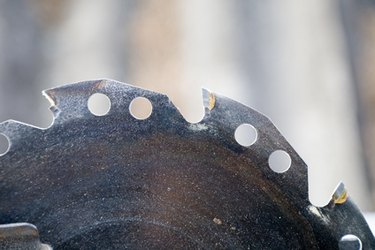
A good circular saw is invaluable for crosscutting, ripping or plunge-cutting lumber. To assess the saw's cutting power, first note the watts of electrical power it uses, which will tell you the saw's demand on your electrical power source and give you a ballpark idea of the tool's might. However, the saw's design determines its rotational power, or torque, and will affect how much power is delivered by the cutting blade.
Wattage
Video of the Day
Wattage offers the most direct measurement of a circular saw's power requirements. According to Diesel Service and Supply, a Colorado-based manufacturer of generators, a typical circular saw requires 2,400 watts to start up, its "starting wattage," and 1,200 throughout operation, its "running wattage." A small circular saw 7.5 inches in diameter will run at closer to 900 watts, according to estimates from the University of Texas' Mechanical Engineering department. Generally, circular saw manufacturers indicate the latter figure, running wattage, in their product details. For example, the Festool TS 55 EQ Plunge Cut Saw requires 1,200 watts, a relatively high wattage for its small 6.25-inch blade diameter. The 7.5-inch Hitachi C7YAH 7 1/4-inch Dust Reducing Circular Saw is relatively more power-hungry, using 1,680 watts of power for running operation.
Video of the Day
Amperage
Commonly indicated on circular saw fact sheets, the amps, or amperes, reflect the amount of electricity that the motor draws. Most circular saws use 15 amps, the lower common capacity of home circuitry, which corresponds to a maximum safe wattage of 1,440 watts. Some models use slightly less; for example, Ryobi's CSB141LZK model comes in at 14 amps and Skil's 5755 at just 13 amps.
Rotations Per Minute
A circular saw does not cut along a single axis but uses power to drive a circular movement. Therefore, note how such a saw's power requirements translate to torque, or circular force. While amperage measures only the draw of electricity, noting a saw's rotations per minute, or rpm, will give you a better idea of how the harnessed power affects performance. For example, worm-drive saws have a different orientation than sidewinders; for the same power requirements, the worm-drive model often generates far more torque. According to "Popular Mechanics," the average circular saw with a 7.25-inch blade runs at around 5,800 rpm. For reference, that translates to around 125 mph. While most rpms hover around the upper 5,000s, Bosch's CS20 model delivers 9,600 rpm, gaining praise from "Popular Mechanics" for its "quiet, powerful operation." By contrast, the Skil 5755, running on 13 amps, performs at 4,600 rpm.